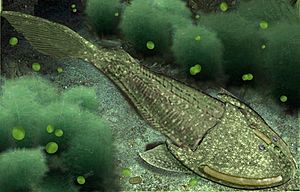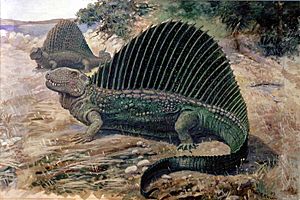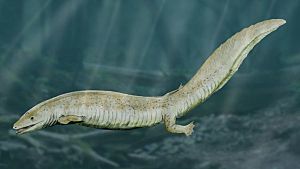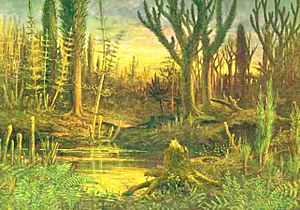Paleozoic facts for kids
The Paleozoic Era was a huge chunk of time in Earth's history. Its name comes from Greek words meaning "ancient life." It's the earliest of three major eras in the Phanerozoic Eon, which is the time when visible life has been abundant. The Paleozoic lasted for a very long time, from about 541 million years ago to 252 million years ago. It's divided into six main periods: the Cambrian, Ordovician, Silurian, Devonian, Carboniferous, and Permian. This era came after the Neoproterozoic Era and was followed by the Mesozoic Era, which is famous for dinosaurs.
The Paleozoic was a time of huge changes for our planet. There were big shifts in geology, climate, and how life evolved. Life started in the oceans, but by the end of the Paleozoic, many different kinds of plants and animals had moved onto land. Giant forests covered the continents, and their remains eventually formed the coal we use today.
The Paleozoic Era ended with the biggest extinction event in Earth's history, called the Permian–Triassic extinction event. This event was so devastating that it took millions of years for life on land to recover.
Contents
Geology and Continents in Motion
The Paleozoic Era began and ended with giant landmasses called supercontinents. At the start, the supercontinent Pannotia was breaking apart. Over time, continents moved, collided, and formed new mountain ranges. For example, the huge continent Gondwana formed early in the Paleozoic. Later, North America and Europe crashed together, creating mountains. By the end of the Paleozoic, all the continents had joined to form the supercontinent Pangaea. This created some of the world's largest mountain chains, like the Appalachians and the Ural Mountains.
Periods of the Paleozoic Era
The Paleozoic Era is split into six periods, each with its own unique story of life and Earth changes.
Cambrian Period: Life Explodes

The Cambrian Period lasted from about 541 to 485 million years ago. It's famous for the "Cambrian explosion," a time when life on Earth suddenly became much more diverse. Most major groups of animals we see today first appeared in the oceans during this period. Creatures like algae became common, but the most widespread animals were armored arthropods, such as trilobites. During this time, the supercontinent Pannotia continued to break up.
Ordovician Period: Fish and First Land Explorers

The Ordovician Period was from about 485 to 443 million years ago. Many animal groups that are still around today evolved during this time, including early fish, squid-like creatures (cephalopods), and coral. Trilobites, snails, and shellfish were very common. Importantly, the first arthropods (like insects and spiders) began to explore the empty landmass of Gondwana.
Near the end of the Ordovician, a major ice age happened. This caused sea levels to drop and led to the Late Ordovician mass extinction. About 60% of marine animals died out, making it the second deadliest mass extinction in Earth's history.
Silurian Period: Life Recovers and Spreads
The Silurian Period spanned from 443 to 416 million years ago. After the ice age, life bounced back! Fish evolved rapidly, with jawless fish becoming more common and the first jawed fish appearing. The first freshwater fish also evolved. Giant sea scorpions were still top predators in the oceans.
On land, true terrestrial life began to evolve. Early spiders, fungi, and centipedes appeared. The evolution of vascular plants like Cooksonia was a huge step. These plants had special tissues to carry water, allowing them to grow taller and spread across land. At this time, there were four main continents: Gondwana, Laurentia (North America), Baltica (Northern Europe), and Avalonia (Western Europe).
Devonian Period: The Age of Fish and First Trees
The Devonian Period, from 416 to 359 million years ago, is often called "The Age of Fish." Fish became incredibly diverse, including armored fish like Dunkleosteus and lobe-finned fish. These lobe-finned fish eventually evolved into the first tetrapods (four-legged animals).
On land, plants also changed dramatically in an event called the "Devonian Explosion." Plants developed lignin, a tough substance that allowed them to grow tall. The first trees and seeds appeared, creating new habitats for arthropods. The first amphibians also evolved, taking their first steps onto land. The Devonian ended with the Late Devonian extinction, the Earth's second mass extinction event, which wiped out about 70% of all species.
Carboniferous Period: Giant Forests and Early Reptiles
The Carboniferous Period lasted from 359 to 299 million years ago. During this time, Earth was very warm, and tropical swamps covered much of the land. Trees grew very tall and dense. Since bacteria and fungi that could break down the tough lignin in these trees hadn't fully evolved yet, the dead plants piled up. Over millions of years, these layers of plant matter turned into the vast coal deposits we find today, which is why this period is called "Carboniferous" (carbon-bearing).
A key evolution was the amniotic egg, which allowed amphibians to lay eggs on land without them drying out. This meant they could live further away from water. The first reptiles and mammal-like reptiles (synapsids) also evolved in these swamps. Towards the end of the Carboniferous, the climate cooled, leading to large ice sheets, especially on Gondwana.
Permian Period: Pangaea and The Great Dying

The Permian Period, from 299 to 252 million years ago, was the last period of the Paleozoic Era. At its start, all the continents had joined together to form the supercontinent Pangaea, surrounded by one huge ocean called Panthalassa. The climate was very dry, with harsh seasons, especially in the middle of Pangaea, far from the ocean's moderating effect.
Reptiles and synapsids (like Dimetrodon and Edaphosaurus) thrived in this dry climate. The first conifers (cone-bearing trees) evolved and dominated the land. However, as the Permian continued, Pangaea became even drier. New species like Scutosaurus and Gorgonopsids appeared.
The Permian Period ended with "The Great Dying," the most severe mass extinction in Earth's history. About 95% of all life on Earth disappeared, marking a dramatic end to the Paleozoic Era.
Climate Changes Through the Paleozoic
The climate changed a lot during the Paleozoic. The early Cambrian was mild, then got warmer as sea levels rose. However, as Gondwana moved south, much of it ended up over the South Pole, leading to colder conditions in some areas. The early Paleozoic ended with a short but intense ice age, which caused a major extinction.
The Ordovician and Silurian periods were generally warm, like a "greenhouse" Earth, with very high sea levels. This warm period was briefly interrupted by the ice age at the end of the Ordovician.
The middle Paleozoic (Silurian and Devonian) was quite stable. Sea levels slowly rose again, and continents merging created new warm, shallow seas. As plants spread on land, oxygen levels in the atmosphere increased, and carbon dioxide levels dropped. The Devonian ended with some extinctions, but life overall remained diverse.
The late Paleozoic (Carboniferous and Permian) saw more dramatic climate shifts. The Carboniferous began with very high oxygen and low carbon dioxide, which led to one or two ice ages. These were much more severe than the earlier ice age, but surprisingly, they didn't cause as much harm to life worldwide. As Pangaea formed, it created vast, dry inland areas with extreme temperatures. The very end of the Permian saw falling sea levels, rising carbon dioxide, and a general worsening of the climate, leading to the devastating Permian extinction.
Flora: Plants Conquer Land
While simple plant life existed in the water very early on, plants mostly stayed in the oceans until the Silurian Period, about 420 million years ago. That's when they started to move onto dry land. Land plants really took off in the Carboniferous Period, when huge lycopsid rainforests covered the tropical parts of the supercontinent Euramerica. However, climate change caused the "Carboniferous Rainforest Collapse," which broke up these forests and reduced the variety of plant life in the late Carboniferous and Permian.
Fauna: Animals Evolve and Spread
A remarkable thing about the Paleozoic is how suddenly almost all major groups of invertebrate animals appeared at the beginning of the Cambrian. The first animals with backbones, primitive fish, evolved and became very diverse in the Silurian and Devonian periods.
The first animals to venture onto dry land were arthropods (like early insects and spiders). Some fish developed lungs and strong, bony fins. Around 367.5 million years ago, these fish used their fins to crawl onto land. The bones in their fins eventually turned into legs, and they became the first tetrapods (four-legged animals) about 390 million years ago. They also began to develop lungs for breathing air.
Amphibians were the main tetrapods until the middle of the Carboniferous, when climate change reduced their numbers. Later, reptiles became more common and diverse, especially by the late Permian.
Images for kids
See also
 In Spanish: Era paleozoica para niños
In Spanish: Era paleozoica para niños





